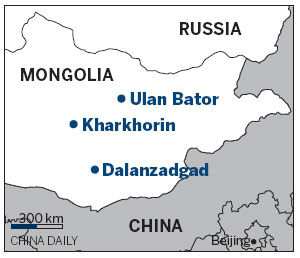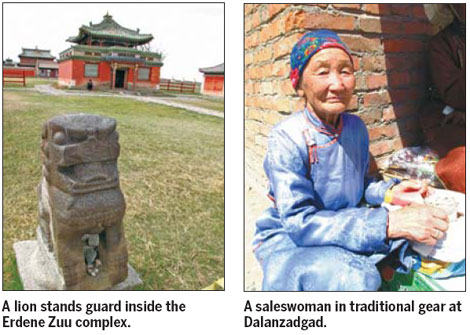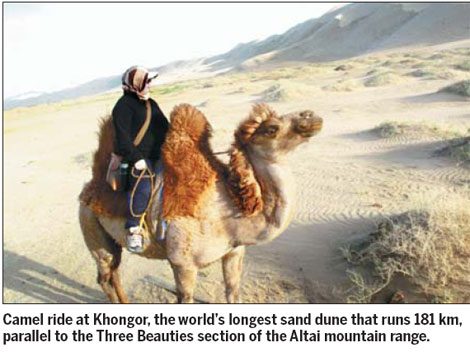A never-ending magic show
 0 Comment(s)
0 Comment(s) Print
Print E-mail
China Daily, July 22, 2011
E-mail
China Daily, July 22, 2011
|
|
|
The flat-topped red cliffs of Bayanzag, in Mongolia's Gobi desert, is famous for dinosaur findings. Tuweimei / for China Daily |
Traversing the Gobi desert from Ulan Bator to Dalanzadgad is a series of natural and man-made wonders, Chitralekha Basu discovers.
If you are planning to fly from the Mongolian capital of Ulan Bator to Dalanzadgad, the provincial capital of Omnogov (south Gobi), to explore the desert, I have a suggestion.
Don't.
For, by flying, you deny yourself the theater of landscapes, the dramatic reversal of terrains and the pure pleasure of absorbing the grandeur of the great void and a near-total silence.
Here's a template of how one might try sampling the wonders of this 165,000 sq km area, its steppes, dunes, canyons, craggy fuchsia-red cliffs and mossy mounds that plunge headlong into thin near-evaporated lakes and permanently snow-covered ravines, sparkling like a bed of crystals under a pitiless midday sun at 50 C.
In the Gobi the journey is often more exciting than the destination and being on the desert road is like passing through a never-ending magic show.
|
|
|
Only three of the 100 temples in the massive Erdene Zuu complex have survived the destruction of the 1930s. Photos by Chitralekha Basu / China Daily |
Day 1
There is no road to speak of, once you get past the ancient capital of Kharkhorin that Genghis Khan built in 1220, 373 km southwest of Ulan Bator. There are only dirt tracks. And when these disappear in the sandy stretches, or end up against a row of granite boulders, balanced precariously on top of each other, keep driving until the next ger (felt-lined circular tents with a hole on top) is sighted.
This is where the nomadic Mongolian herdsmen live with their flocks, and they will likely point you in the right direction. Clad in traditional del (loose overalls, buttoned up on the right and tied at the waist using a cummerbund) and mounted on horseback, they are often camera shy. So do ask before you start clicking.
Downtown Kharkhorin is a dusty market, where most of the shops are run from discarded railway compartments, some of these painted the color of milk of magnesia. The most conspicuous items on sale are fur-lined leather boots and sunglasses - reflecting the extremes of weather that mark the Mongolian steppe.
Erdene Zuu monastery, built in the 16th century on the remains of Kharkhorin, was torn down during the Stalinist purges of the 1930s. Only three of the 100 temples survived the onslaught. But the complex, with 108 Buddhist stupas dotting its boundary wall, is still dazzling white.
The enormous turtle rock, one among four that once marked the territory of Kharkhorin, 300 meters northwest of the monastery, is still a passive confidant to anyone who wants to share her story. Local Mongolians are often seen whispering in its ears.
Day 2

The sparse green cover on the ground begins to give way to an almost-bare expanse, stretching out into the horizon, punctuated by thorny clusters, holding the loose soil together in tiny arcs. The only visible feature is an occasional oovoo (a heap of stones that gathers bulk, height and shamanistic connotations as each passer-by adds his/her own pebble, sometimes laying down a blue scarf, bottle of liquor or an ibex head, as offerings).
Suddenly, charcoal black hills pop up. The soil goes black too. My guide, Khiske, tells me these hills were set on fire during the Stalinist purges and blazed for months on end.
The target of their ire was Ongi temple on a mountain slope by the river. Over 1,000 Buddhist monks lived in the monastery, most of whom were killed.
With broken, corroding pillars of stone and truncated mud walls, Ongi would look more like a ghost town if it wasn't for the monastery finding a fresh lease of life recently when a new lama designate was found in the locality.
By the time we reach Ongi the induction ceremony for the new incumbent is over, and the ger in which it was held is being dismantled. The guardian of the premises excitedly shows us painted wooden beams preserved from a demolished temple in the 1930s and hopes it will be used to build a fresh structure.
We drive south across a sandy turf for about 160 km. The flat-topped red cliffs of Bayanzag spring into view. Christened the "flaming cliffs" by the American paleontologist Roy Chapman Andrews, who discovered dinosaur skeletons here in 1922, Bayanzag is the only place in Gobi where I saw trees - the generic saxaul - in a landscape that Salvador Dali might have painted. The trunks are blanched white, tying themselves up in knots as the branches rise into the sky like unmanageable frizzy hair. A deep purple-colored wild flower, like iris, grows on the shaded side of the cliffs. The driver insists it has therapeutic values and starts munching on a stalk.
Day 3

Two things happen, at once, at Khongoryn Els. Driving southwest for about 200 km, as soon as we cross to the southern side of the dark hills, a blistering wind overpowers us. A gray range stretching into the distances is etched against a darker, taller ridge in the background. The former, Khongor's chief attraction, is arguably the world's longest sand dune stretching for 181 km. The latter is the famed Three Beauties section of the Altai mountain range. The dunes are supposed to "sing" - to the discerning ear - but all we can hear is a mad wind hissing and rattling the windowpanes.
We had almost given up on our plan of checking out the dunes up close when the wind drops, almost completely, without warning. Thankfully, the sun doesn't set on the desert until about 9:30 pm in summer. So the day is saved, complete with the mandatory camel ride.
Astride a camel one can truly appreciate how the dunes change color, from rose-hued to golden to white to gray to a darker silhouette, depending on the time of the day and/or the angle at which the sun shines on it.
Day 4

Driving southeast, running parallel to the Altai, we stop to talk to a nomadic family. For many of these new-age nomads, the power bike is a popular mode of transport, although its predecessor, the horse, is still effective. Solar power is harnessed to run a TV at night, the solar panel and re-chargeable batteries packed and carried along when the family moves base twice every year.
At Yoln Am (Vulture's Mouth), a light snow begins to fall in perfect round droplets. As we walk toward the gorge, hills appear, on either side, crouching like predatory beasts. A little ahead is a path paved with ice that does not melt even under the glare of the relentless desert sun.
We walk the 2.5 km sparkling-white stretch, kicking up sprays of crystalline ice along the way, like unruly children.
Day 5
The flat, bare expanse begins to lump up and harden into granite rock formations as we drive toward middle Gobi. The car wobbles, going downhill over a pebbly slope. The hills rise in height, rocks turn into knobby, gigantic boulders.
At Baga Gazriin Chuluu, the driver, Orkho, removes a stone lid to reveal a little hole on the granite surface. There's water inside, ostensibly a subterranean spring that is therapeutic for the eyes. A stone's throw away is a cave with an underground lake. The terrain is dotted with miniature oovoo, with green and blue scarves tied to them blowing in the wind.
Not too far away is yet another vandalized monastery, its half-razed walls inscribed with Tibetan script. It used to be a retreat of somewhat artistic monks, who translated, made prints and had a more than passing interest in the scriptures. It also had a choir. Kiskhe tells me the monastery was attacked twice.
After the massacre in the 1930s, they tried to pick up the broken pieces and start a school. But one night the children were poisoned and died en masse. Since then the place has not attracted too many people beyond the odd tourist.

Kiskhe points toward the thickets of magenta-red blossoms growing on the ruins. "They say it's because so many children died here," she says.
I couldn't remember seeing such an intense burst of fresh foliage anywhere else in the desert.
If you go
Getting there: Air China and Mongolian Airlines operate daily flights from Beijing to Ulan Bator (UB). Return airfare for the two-hour journey hovers between $410 and $590, so watch out for discounted rates and book early.
To get to south Gobi, it’s best to book with a reputed tour operator in UB. I went with black Ibex Expeditions (http://www.discovermongolia.mn). A five-day driving holiday across middle and south Gobi, including a visit to the ancient capital Erdene Zhu in central Mongolia, cost around $1,600 for a single traveler. Driver, translator-guide servers are provided and all meals, accommodation and entrance fees to museums, archaeological sites, camel rides and so on are covered. The cost per person could be significantly reduced if you are travelling in a group.
Accommodation: There is a range of decent hotels in UB, tariffs ranging from around $150 a night to as low as $28 for accommodation in hotels.
In the desert you get to spend the nights in Mongolian gers (circular felt tents, with a hole on top). Costs are around $60 per person, including breakfast.
Food: if you don’t like meat, tell your tour operator in advance, although this will be seriously limit your choice to potatoes, carrots and capsicum, once you are in the desert. Typical meals are a variation of chunks of meat (beef, lamb and the most tare pork or chicken) boiled in a broth with noodles, or steamed as fried dumplings with minced meat fillings.
If you are visiting a nomadic family, it’s likely they will offer you fermented camel’s milk, aarul (hardened cubes of curd, left to dry for months together), dry meat, milk tea with salt. Being able to appreciate these are often an acquired taste, so if you are not feeling up to the adventure, politely decline.







